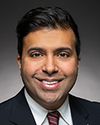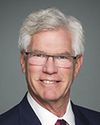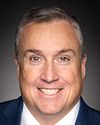No offence was intended. I'm certainly happy to rephrase the question.
If an unregistered firearm were used, what would that do to the workload and the work that you would have to do to be able to trace that weapon?
Evidence of meeting #4 for Public Safety and National Security in the 44th Parliament, 1st Session. (The original version is on Parliament’s site, as are the minutes.) The winning word was smuggling.
A recording is available from Parliament.
12:35 p.m.
Liberal

Taleeb Noormohamed Liberal Vancouver Granville, BC
No offence was intended. I'm certainly happy to rephrase the question.
If an unregistered firearm were used, what would that do to the workload and the work that you would have to do to be able to trace that weapon?
12:35 p.m.
D/Commr Stephen White
Obviously, there's more work from tracing it back because it was an unregistered firearm. With the serial number, we can trace some of it back. The big piece here would be working with the police agency to determine the circumstances of the criminal investigation that resulted in the seizure of that firearm and whether that firearm was registered as being lost or stolen at some point in the past. The work required could vary, depending on the nature of the criminal investigation the firearm was seized in and the circumstances of the firearm, whether it was lost, stolen or possibly diverted at some point as well.
12:35 p.m.
Liberal

Taleeb Noormohamed Liberal Vancouver Granville, BC
I have another question for you, recognizing I'm running out of time here. With the number of non-registered firearms you are seeing, do you think we should be putting more emphasis on trying to figure out how to address that matter? What would you recommend by way of feedback or advice to folks who have non-registered firearms who may not have them for illegal purposes?
12:35 p.m.
D/Commr Stephen White
Again, there are a number of circumstances with that. We'd look at it. Were unregistered firearms seized? Could we trace it back to it being part of a straw purchasing activity, whereby a legal licence owner is going and purchasing unregistered firearms legally and then diverting those, for example, into the illicit firearms market?
I will ask Ms. Paquette if she has anything to add.
12:35 p.m.
Director General, Canadian Firearms Program, Royal Canadian Mounted Police
No. The only thing I would add is around the tracing and the Internet investigations that are also completed as part of our package when we get that firearm.
12:35 p.m.
Liberal

Taleeb Noormohamed Liberal Vancouver Granville, BC
I will give those back to the committee.
Thank you, Mr. Chair.
12:35 p.m.
Liberal

The Chair Liberal Jim Carr
Thank you.
Then we'll segue right into Ms. Michaud, who has two and a half minutes.
The floor is yours.
12:35 p.m.
Bloc

Kristina Michaud Bloc Avignon—La Mitis—Matane—Matapédia, QC
Thank you, Mr. Chair.
I'll speak to Mr. White from the RCMP.
Mr. White, in your opening remarks, you spoke of the seizure of 53 pistols and 6 rifles. That seizure took place in the past year. It's hard to say whether it's a good seizure, because we don't know how many firearms were brought across the border or how many will end up on the streets of Montreal.
A few days ago, the investigation office of the Journal de Montréal revealed that about 2,000 illegal weapons are circulating in Montreal alone. According to our figures, this seizure seems minimal.
Why are there so few seizures at the border?
12:35 p.m.
D/Commr Stephen White
In my opinion, we conduct seizures at the border quite regularly.
Mr. Duheme, did you want to add something?
12:35 p.m.
D/Commr Michael Duheme
I am aware of this article in Le Journal de Montréal. If memory serves, this seizure was made between ports of entry. This is a route that people use to smuggle contraband into Canada.
As I explained earlier, when we're between ports of entry, it's a challenge, given the geography and the length of the border.
I have nothing to say about the impact of the 53 firearms, because I can only make assumptions. Yet we know that these firearms entered the country illegally.
12:35 p.m.
Bloc

Kristina Michaud Bloc Avignon—La Mitis—Matane—Matapédia, QC
You talked about the complexity of the territory and the length of the border. As we know, there are many firearms that come through Akwesasne territory. Earlier, you talked about working with their police department, but I feel that more could be done.
Do you have any indication of how many guns transit through this territory on a daily, weekly or monthly basis?
12:35 p.m.
D/Commr Michael Duheme
No, I do not.
The Akwesasne route has been known to smugglers for a long time. However, I can assure you that we are working closely with the Akwesasne Mohawk Police Service, the Sûreté du Québec detachment in Salaberry‑de‑Valleyfield and the one in Cornwall, our American partners at U.S. Customs and Border Protection, and our integrated teams.
12:40 p.m.
Liberal

The Chair Liberal Jim Carr
Thank you very much.
Mr. MacGregor, it's over to you for two and a half minutes. The floor is yours.
12:40 p.m.
NDP

Alistair MacGregor NDP Cowichan—Malahat—Langford, BC
Thank you very much, Mr. Chair.
Maybe I'll give Mr. Sauvé a chance to answer some questions here.
Mr. Sauvé, in my riding of Cowichan—Malahat—Langford out here on Vancouver Island, we are 100% policed by the RCMP. I know, from the good relations I have with many members, the difficult job they do every day. They have certainly reiterated many of the staffing and resource challenges you mentioned in your opening statement.
Indeed, with the raging opioids crisis that's going on in my community, many are being called to intervene in a lot of mental health and addictions work, because we don't have those other resources either.
You mentioned the successful Surrey RCMP “Shattering the Image” anti-gang program. Previously, your organization has called for legislation to effectively address gang diversion.
I don't have much time. I have about a minute and a half. Can you maybe elaborate a little bit more on how that anti-gang program has been successful and some of the key details and legislation you're referring to? The Criminal Code often comes into effect after the fact. I'm more interested in what kind of proactive policies and legislation we can be enacting at the federal level.
Thank you.
12:40 p.m.
President, National Police Federation
Yes. I mentioned the Surrey RCMP “Shattering the Image” program. Obviously, there are a number of them. One of the other ones is the end gang life program of the Combined Forces Special Enforcement Unit in British Columbia. It has to do with a lot of community outreach and education.
Ultimately, they are extremely blunt in the message they deliver through public advertising, Twitter, youth outreach and school liaison programs. If you see some of the CFSEU ads, it is blunt advertising, that speaks to the target audience of youth looking to get into the “classy” life of crime and organized crime. There are pictures of caskets and little stories and snippets.
From that perspective, it's really about engagement and the partnership of law enforcement agencies with those community outreach programs and ensuring there are some metrics in place to make sure that we're spending our dollars wisely and pushing the right message that is having an impact.
12:40 p.m.
Liberal

The Chair Liberal Jim Carr
Thank you very much.
Now I will ask Mr. Shipley to begin his five minutes. He has the floor.
12:40 p.m.
Conservative

Doug Shipley Conservative Barrie—Springwater—Oro-Medonte, ON
Thank you, Chair.
I'm not a gun owner myself and don't profess to be an expert on guns, but there have been some tragic events lately south of my riding in the GTA area, and more so right in Barrie recently, where a young teen was shot to death.
With the influx of handguns, I sometimes wonder where these young teens have been getting the money to purchase them. If so many are coming across the border—maybe someone from the RCMP would happen to know this—what do illegal handguns cost on the black market?
12:40 p.m.
D/Commr Michael Duheme
I can't speak specifically for the Toronto area, but in the conversation with Madame Michaud earlier, in the article she was referring to in Le Journal de Montréal, the local paper in the city of Montreal.... My recollection—and I'm not going to say just handguns, but firearms—is that it varies from $1,000 to $8,000. Madame Michaud can correct me if I'm wrong, but that's my recollection.
For an illegal firearm on the market, that's the going price in Montreal and, I'd venture to say, in the province.
12:40 p.m.
Conservative

Doug Shipley Conservative Barrie—Springwater—Oro-Medonte, ON
That brings up some questions about where young teens aged 13 and 14 are getting $1,000, even on their own.
Perhaps this may lead into it, and maybe one of our counterparts from the RCMP can answer. I'm not sure whom exactly to direct this. How large of a role do gangs or organized crime play in the cross-border smuggling of firearms, and what is the best way to combat this?
12:45 p.m.
D/Commr Stephen White
Go ahead, Mike.
12:45 p.m.
D/Commr Michael Duheme
To your question, sir, I would say a huge part of that, anywhere there's some monetary gain to be made.... They're bringing it in for the sole purpose of reselling it to people. The information I've seen is really towards the street gangs that are bringing it in, and then selling it to people, like the examples you provided in Toronto.
I'll pass it over to Steve, if he has more statistics from the CISC.
12:45 p.m.
D/Commr Stephen White
Thanks, Mike, for that.
You just look at the landscape for organized crime, and I would invite everyone to look at it.
Last week, we released a public report on organized crime in Canada. The purpose of the report is to help raise public awareness of organized crime groups operating in Canada and really give us, law enforcement and the government, that perspective.
As a snapshot, CISC, Criminal Intelligence Service Canada, estimates there are 2,600 organized crime groups known and believed to be operating in Canada. CISC assessed 469 of them during its threat assessment last year. A number of them were identified as high-level threats and very much heavily involved in the narcotics trade. I think 250 organized crime groups were assessed as being involved in the fentanyl market and 300-plus organized crime groups were involved in the methamphetamine market.
With the drug trafficking environment goes the use of firearms by organized crime groups or by gangs somewhat recruited by organized crime groups to assist with street-level distribution and street-level trafficking of drugs. That's where you can go back to where they're making the money. That's where the money comes in.
A lot of gangs are supported and financed by the work they're doing on behalf of organized crime groups.
12:45 p.m.
Conservative

Doug Shipley Conservative Barrie—Springwater—Oro-Medonte, ON
Thank you for that, Mr. White.
I'm going to ask a very pertinent question. Do you believe, then, that we have a handgun issue or an organized crime issue in Canada ?
12:45 p.m.
D/Commr Stephen White
Both.